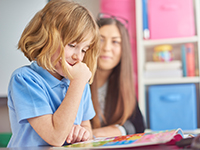Phonics
 Schools teach children to read and write using a method called phonics.
Schools teach children to read and write using a method called phonics.
This page explains phonics and tells you about tools you can use to help your child at home.
Phonics in school
Phonics is taught to children in year 1 and 2 to provide them with the knowledge to “de-code” any new words that they might hear or see.
When learning phonics a child should be able to:
- recognise the sounds that each individual letter makes;
- identify the sounds that different combinations of letters make - such as ‘sh’ or ‘oo’; and
- blend these sounds together from left to right to make a word.
These are the first important steps in learning to read.
The importance of phonics – why it is taught
Evidence suggests that a child who receives good teaching of phonics will learn the skills they need to tackle new words. This will equip children to read any kind of text fluently and confidently, and children who learn in this way tend to find more enjoyment in reading.
Children who have been taught phonics also tend to read more accurately than those taught using other methods. This includes children who find learning to read difficult, such as those who have dyslexia.
More information about phonics and why it is taught in schools is available on the Department for Education website.
The phonics screening check
In year 1 your child will undertake the phonics screening check. Children that do not meet the year 1 standard will retake the check in year 2.
The check is a short, light-touch assessment to see if your child’s phonic knowledge is of an appropriate standard. Your child should not realise that they are being formally assessed. Children should see the check as part of their everyday phonics activities and not as a test.
Non-words
Made up words are included in the check to ensure there is no bias to those with a good vocabulary knowledge or visual memory of words. Children who can correctly read non-words are showing that they have the skills to decode almost any unfamiliar word that they might come across.
After the phonics check
The results of the phonics screening check are not made public, however your school should tell you about your child’s progress in phonics and how they have done in the check in the last half-term of year 1.
If your child has found the check difficult, your child’s school should also tell you what support they have put in place to help them improve.
Do not worry if your child does not meet the required standard. All children develop at different rates.
The screening check ensures that teachers understand which children need extra help with phonic decoding. You might like to ask how you can support your child to take the next step in reading.
What you can do as a parent
Talk to your teacher
Talk to your teacher about the school’s approach to phonics and how you can reinforce this at home. For example, the teacher will be able to tell you which letters and sounds the class is covering in lessons each week. There are three different phoincs schemes that schools use to teach the subject, make sure to ask which scheme your school uses.
Encourage ‘sounding out’
When reading, encourage your child to ‘sound out’ unfamiliar words and then blend the sounds together from left to right. Make sure they avoid looking at the pictures or other context provided in the writing to guess. Once your child has read an unfamiliar word you can talk about what it means and help him or her to follow the story.
Decodable books
Your child’s teacher will also be able to suggest books with the right level of phonics for your child. These books are often called ‘decodable readers’ because the story is written with words made up of the letters your child has learnt. Your child will be able to work out new words from their letters and sounds, rather than just guessing.
Read with your child
Try to make time to read with your child as much as possible, you cannot read too much. Encourage your child to blend the sounds all the way through a word. You can also encourage your child to read words from your shopping list or road signs to practise phonics.
Book bags
Most schools use ‘book bags’ and a reading record, which is a great way for teachers and parents to communicate about what children have read. The reading record can tell you whether your child has enjoyed a particular book and shows problems or successes he or she has had, either at home or at school.
Tricky words
Not all words in the English language can be sounded out phonically as they contain letters that don't represent their normal sounds. These words are known as “tricky words.”
If you encounter any of these words you should encourage your child to be able to use their phonics knowledge to help them read the word as best as they can, but the tricky parts of the word that cannot be decoded using phonics will need to be learned by sight. An example of a tricky word would be the word, “said.”
Learning materials
Below are a range of learning materials that you could use with your child.